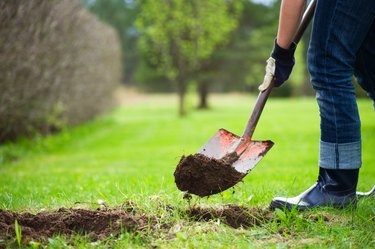
What is backfill, and why would homeowners need to use it? Simply put, backfill is a natural material used to fill in voids that are left after excavation and construction work. It is soil, sand and stone (or a mixture of these in different combinations) that might be already there from completed work or transported to sites if needed.
Backfill is commonly used to fill areas around home foundations, swimming pools, pipes and trenches. With foundations, it is often necessary to direct water away and minimize the risk of deterioration that could compromise the structure's integrity.
Video of the Day
Video of the Day
Best Backfill Material for Foundation
With new homes, backfilling is usually done with on-site compactable dirt free of organic materials that could decompose and lead to unwanted settlement. Avoid using dirt that has materials like wood scraps, topsoil, tree stumps and roots. If enough appropriate fill dirt is unavailable, you may need to bring in stone or gravel for the backfill. These options are good choices since those materials compact well and allow water to run through them.
Keeping water away from the home foundation is an imperative part of building a home because water can cause foundations to crack over time. This cracking is how leaks start, which can turn into extensive, costly problems down the road. Don't dig up soil from the ground to use as a backfill either because it is not compacted enough. That soil contains air and space since it has been there for a while, as dirt loosens over time.
Sand for Filling
Sand backfill is frequently used for construction projects and is made up of fine rocks and particles that have eroded and broken down over a longer period of time. However, while sand does have a high compaction rating, it is generally susceptible to displacement and shifting. Backfill sand is used for concrete bases around swimming pools, septic tanks, landscaping projects in trenches and backfilling the joints between paver stones.
However, backfilling with sand is never recommended for projects that require fill dirt. The main reason for this is that sand can draw in moisture, which can be problematic around home foundations. Sand does allow for drainage and is easier to use, which is why it works well in wetter areas. It is sold in bags at home improvement stores, hardware stores and online; for larger projects, it can be ordered by the ton and delivered by construction supply companies.
Can I Use Gravel Backfill?
Gravel is made of different rocks, and pea gravel is commonly used in landscaping. It prevents erosion, and you can mix it into the soil for this purpose. On its own, gravel is generally used as a finishing material instead of a backfill material. It's a fine mulch, as it prevents soil surface evaporation and prevents the soil from moving around.
To improve drainage, you can also put gravel at the bottom of hills or around your house's drainpipes. You can also add gravel to the dirt backfill used around foundations, as it aids in compaction. However, a soil compacter may be needed to condense the soil; these are heavy plates that slam down on the fill material.
Gravel can settle over time, though, and more dirt may need to be added. If it shifts, the nearby materials and property could be damaged. Exposed gravel and sand will wash away over time, but with backfill, they are always covered with other materials to prevent that from happening. Sand is the recommended backfill for septic tanks and pools because it is unlikely to move around the pipes once it is filled in.